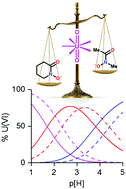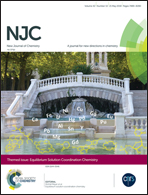Effects of preorganization in the chelation of UO22+ by hydroxamate ligands: cyclic PIPO−vs. linear NMA−†
Abstract
Many siderophores incorporate as bidentate chelating subunits linear and more seldomly cyclic hydroxamate groups. In this work, a comparative study of the uranyl binding properties in aqueous solution of two monohydroxamic acids, the prototypical linear N-methylacetohydroxamic acid (NMAH) and the cyclic analog 1-hydroxypiperidine-2-one (PIPOH), has been carried out. The complex [UO2(PIPO)2(H2O)] crystallized from slightly acidic water solutions (pH < 5), and its molecular structure was determined by X-ray diffraction. The uranyl speciation in the presence of both ligands has been thoroughly investigated in a 0.1 M KNO3 medium at 298.2 K by the combined use of four complementary techniques, i.e., potentiometry, spectrophotometry, Raman spectroscopy, and affinity capillary electrophoresis. Preorganization of the hydroxamate ligand for chelation by incorporation into a cyclic structure, as in PIPO−, results in an increase of nearly one order of magnitude in the formation constants of the uranyl complexes of 1 : 1 and 1 : 2 metal/ligand stoichiometries.

- This article is part of the themed collection: Equilibrium Solution Coordination Chemistry


 Please wait while we load your content...
Please wait while we load your content...